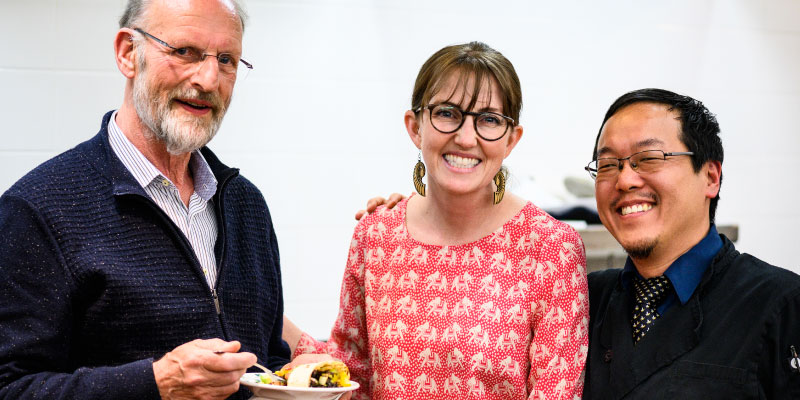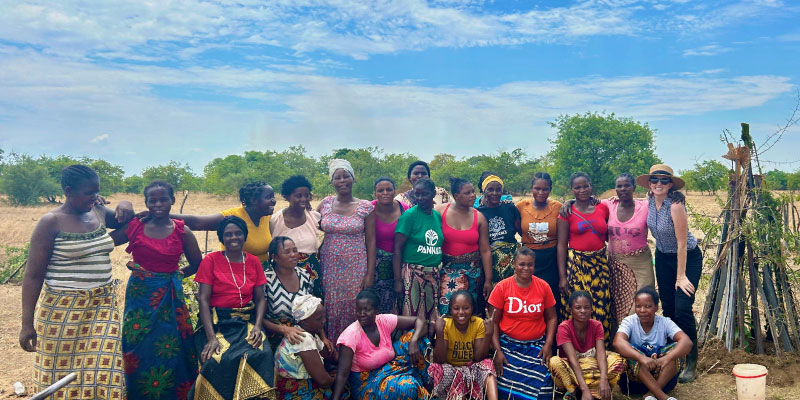
When it’s Valerie Stull’s turn to send snack to her preschooler’s school or gathering, she doesn’t send cookies or string cheese. She sends cricket chips. They’re easy to make (just mix cricket powder, corn flour, water, spices, and bake until crisp), they’ve got a nutty flavor profile, they’re packed with protein — and the kids love them. Insects just may be one of the planet’s most sustainable, yet underutilized (at least in western countries), sources of nutrition. And using this protein to share sustainable, tasty treats isn’t just an area where Stull dabbles; she’s a leading expert.
Stull’s job title is complex. “If you asked me, I would say I am an interdisciplinary environmental health scientist,” she says. “I’m passionate about the health and well-being of people and the planet.” Seventy-five percent of the time, she’s a faculty associate at the University of Wisconsin–Madison in both the Nelson Institute and the College of Agricultural Life Sciences. The other 25 percent, she consults with organizations around the world on projects related to agriculture, nutrition, climate change, and sustainable food systems. (And, of course, the other 100 percent of the time, she’s a mom.)

Her journey to crickets (“the gateway bug,” she says) started not in entomology, but nutrition. With a bachelor’s in nutritional science from Colorado State University, a master’s in public health nutrition from Kansas State University, and work experience with U.S. Agency for International Development programs, she traveled the world exploring interventions to bring healthier food to places of need — from schools in sub-Saharan Africa and Madagascar to hospitals in the West Bank. “We were always talking about ‘nutrition,’ but we weren’t talking about food or agriculture,” she says. “All the conversations we were having were centered around crop nutrients … we weren’t talking about how they were grown; we weren’t talking about how they were processed. We weren’t talking about climate change and how it’s making it harder to grow food.” She also noticed some seats missing from the health policy discussion table: farmers and agriculture policymakers.
This left her with questions; lots of them. “I really had interdisciplinary questions,” she reflects. “I had questions that required qualitative methods and questions that required quantitative methods to answer. In the real world, what actually works?” Wanting to understand the systems surrounding health and nutrition — agriculture, policy, the environment, climate change — she looked for a PhD program that would support her varied questions. She found it with the Nelson Institute’s environment and resources track.
“All the conversations we were having were just about the nutrients in the crops … we weren’t talking about how they were grown; we weren’t talking about how they were processed.” — Valerie Stull
While working toward her degree, she took classes in environmental studies, agronomy, epidemiology, and even remote sensing. In her second semester, she joined the Nelson Institute’s Center for Sustainability and the Global Environment, working in a lab group under Jonathan Patz, the Nelson Institute’s John P. Holton Chair in Health and the Environment. Her interests in the health, sociological, and environmental aspects of food systems came together when she started exploring insects as a sustainable food source. From there, she ran laboratory experiments, an ethnographic qualitative field study, and a clinical trial, which culminated in a study published in Scientific Reports. “Impact of Edible Cricket Consumption on Gut Microbiota in Healthy Adults” has since been cited by over 100 news sources and remains one of the highest-ranking articles today. (Stull and the original team just completed a follow-up to that study, where they looked at how isolated insect fiber affects people with irritable bowel syndrome. It was just published in September 2025.)
“I never had plans to stay in academia,” Stull says, but a postdoc opportunity in the UW’s Global Health Institute — then led by Patz — kept her on campus. There, she learned that careers in the academic sector weren’t as black and white as she thought. “I found out about non-tenure track careers at the UW that I didn’t really know existed, like scientist and extension roles.” Stull is now a colead of the Soil Health and Agroecological Living Lab (SHALL) and a researcher with the Climate Solutions for Health Lab. She built a career that’s as interdisciplinary as her interests: from teaching undergrads in both the global health and agroecology majors to conducting research on soil health and farmer experiences across Wisconsin to starting and leading a global nonprofit that connects health, justice, and the environment with a focus on women. Stull’s arc shows that a PhD, particularly from the Nelson Institute, can offer breadth and depth. “One thing I always wanted to do was be able to sit in a room and understand what everyone is saying, not just the nutritionists or not just the farmers,” she says. “I wanted to get a PhD so that I could effectively translate acrossdisciplines.”

Timeline
Girl, AlMIGHTi
During her PhD work, she lived and conducted research in Zambia for a year through a Fulbright Scholarship. But Stull was no stranger to Africa; since 2008, she’d worked on several agriculture-, health-, and gender-related projects in countries including Kenya and South Africa. Building on those decades of work, she started a long-term research project with a UW colleague called MIGHTi: the Mission to Improve Global Health Through Insects. As Stull’s knowledge and network grew, so did the project: in 2022, MIGHTi became a registered nonprofit (thanks to support from cofounder, Brittney Sly) added Mwansa Mwatokwani as its Zambia-based director, and changed the i from insects to innovation. MIGHTi now focuse on women with a mission to improve health and wellbeing through innovation, collaboration, and environmental stewardship.
Face Your Bug Bias
Beyond touting the nutritional and sustainable aspects of edible insects, Stull also breaks down cultural barriers that give Americans the “ick response.” On campus, she’s helped organize Swarm to Table, a celebratory and positive event focused on the many benefits and beauty of insects, now in its fifth year. That’s where she had one of her favorite insect preparations: scorpion crackers. “Not technically an insect, but a colloquial insect,” she adds. Their flavor? “Kind of cheesy.” If you’re still getting the ick, that’s okay. Some insects are still tough for Stull to stomach, too, particularly caterpillars. “The texture is so … chewy.”
Crank that Soldier Fly
When it comes to edible insects, Stull doesn’t just think about humans. Many other animals — like chickens — naturally find arthropods appetizing … what would happen if we could feed them nutritious bugs while reducing waste at the same time? With the Department of Animal and Dairy Sciences, Stull is working to establish a black soldier fly colony on campus. “Our goal is to use food waste from the dorms and dining halls (that in most cases is otherwise going to landfills) to feed black soldier fly larvae (BSFL). Next, we’ll feed those insects to chickens,” she explains. BSFL can eat pretty much anything, and they break waste down much faster than traditional composting. Plus, when they’re done, you don’t just have compost — you have an incredibly well-fed pupa which makes a very nutritious snack for chickens or fish. “We also plan to run a full life cycle assessment with the Office of Sustainability, looking at resources required for insect production along with the nutritional quality of the insects, and long-term we will assess the quality of eggs and well-being of the birds fed those insects,” Stull says. “The idea is to see how this could work on farms across Wisconsin.”
Get your [Fridge] Together
Stull is confident that long-term and large-scale edible insect agriculture could make a huge impact on the sustainability of our food systems. But she acknowledges that no single food or agricultural system is perfect (“It’s not like biking where there’s just benefits.”), and there is no one-size-fits-all solution for our food challenges. But truly impactful change can also start in every household. “Just reorganize your fridge,” she instructs. “That way you won’t forget what you bought that is most perishable. You’ll eat it first.” In the U.S., 30–40 percent of food goes to waste, meaning that all the energy, labor, water, and resources that went in to producing that food is also going to waste. “Food waste is one [problem] where every single person can take action on their own.”